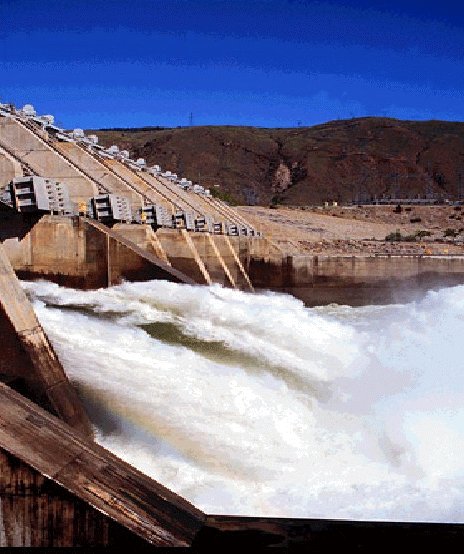Pacific Salmonids: Major Threats and Impacts
Salmonid species on the west coast of the United States have experienced dramatic declines in abundance during the past several decades as a result of human-induced and natural factors. There is no single factor solely responsible for this decline. Given the complexity of the salmon species life history and the ecosystem in which they reside, it is difficult to precisely quantify the relative contribution of any one factor to the decline of a given species. Rather, given the available data, it is only possible to highlight factors which have significantly affected the status of a particular species.
 |
| Hydropower Photo: NOAA |
Water storage, withdrawal, conveyance, and diversions for agriculture, flood control, domestic, and hydropower purposes have greatly reduced or eliminated historically accessible habitat and/or resulted in direct entrainment mortality of juvenile salmonids. Modification of natural flow regimes have resulted in increased water temperatures, changes in fish community structures, depleted flows necessary for migration, spawning, rearing, flushing of sediments from spawning gravels, gravel recruitment and transport of large woody debris. Physical features of dams, such as turbines and sluiceways, have resulted in increased mortality of both adults and juvenile salmonids. Attempts to mitigate adverse impacts of these structures have to date met with limited success.
 |
| Forestry Photo: NOAA |
Natural resource use and extraction leading to habitat modification can have significant direct and indirect impacts to salmon populations. Land use activities associated with logging, road construction, urban development, mining, agriculture, and recreation have significantly altered fish habitat quantity and quality. Associated impacts of these activities include: alteration of streambanks and channel morphology; alteration of ambient stream water temperatures; degradation of water quality; reduction in available food supply; elimination of spawning and rearing habitat; fragmentation of available habitats; elimination of downstream recruitment of spawning gravels and large woody debris; removal of riparian vegetation resulting in increased stream bank erosion; and increased sedimentation input into spawning and rearing areas resulting in the loss of channel complexity, pool habitat, suitable gravel substrate, and large woody debris. Studies indicate that in most western states, about 80 to 90 percent of the historic riparian habitat has been eliminated. Further, it has been estimated that during the last 200 years, the lower 48 United States have lost approximately 53 percent of all wetlands. Washington and Oregon's wetlands have been estimated to have been diminished by one third, while it is estimated that California has experienced a 91 percent loss of its wetland habitat.
The degree of spatial and temporal connectivity between and within watersheds is an important consideration for maintaining aquatic riparian ecosystem functions. Loss of this connectivity and complexity, such as the loss of deep pool habitats, has contributed to the decline of salmon. In Washington, the number of large, deep pools in National Forest streams has decreased by as much as 58 percent due to sedimentation and loss of pool-forming structures such as boulders and large wood. Similarly, in Oregon, the abundance of large, deep pools on private coastal lands has decreased by as much as 80 percent.
Salmon have been, and continue to be, an important target species for recreational fisheries throughout their range. During periods of decreased habitat availability, the impacts of recreational fishing on native anadromous stocks may be heightened. Commercial fishing on unlisted, healthier stocks has caused adverse impacts to weaker stocks of salmon, and illegal high seas driftnet fishing in past years may have also been partially responsible for declines in salmon abundance. However, such fisheries cannot account for the total declines in salmon abundance in North America.
 |
| Fisheries Photo: NOAA |
Introduction of non-native species and modification of habitat have resulted in increased predator populations and salmonid predation in numerous river and estuarine systems. Piscivorous birds such as terns and cormorants, and pinnipeds such as sea lions and harbor seals are examples of potential salmon predators. Marine predation is also of concern in areas of dwindling salmon run-size. In general, predation rates on salmon are considered by most investigators to be an insignificant contribution to the large declines observed in west coast populations. However, predation may significantly influence salmonid abundance in some local populations when other prey are absent and physical conditions, such as narrow river mouths or human-made barriers such as fishing locks, lead to the concentration of adult and juvenile salmonids.
Natural environmental conditions have served to exacerbate the problems associated with degraded and altered riverine and estuarine habitats. Recent floods and persistent drought conditions have reduced already limited spawning, rearing, and migration habitat. Furthermore, climatic shifts over a decadal time scale appear to have resulted in decreased ocean productivity which may exacerbate degraded freshwater habitat conditions to some degree. Environmental conditions such as these have gone largely unnoticed until recently, when salmonid populations have reached critical low levels.
In an attempt to mitigate for lost habitat and reduced fisheries, extensive hatchery programs have been implemented throughout the range of salmon on the west coast. While some of these programs have been successful in providing fishing opportunities, the impacts of these programs on wilds stocks are not well understood. Competition, genetic introgression, and disease transmission resulting from hatchery introductions may significantly impact the production and survival of wild salmon. Commercial and recreational fisheries targeting stronger stocks supported by hatchery production may inadvertently result in adverse impacts to weaker, wild stocks. Furthermore, collection and utilization of wild fish for broodstock purposes may result in additional negative impacts to small or dwindling natural populations.